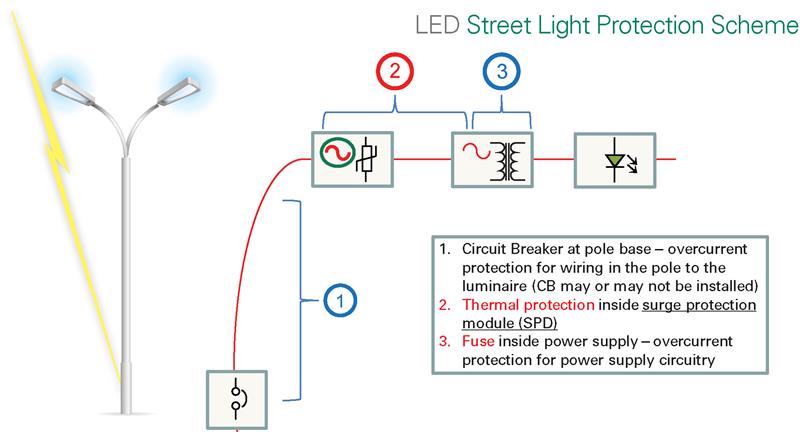To guard against premature failures, particularly due to lightning-induced surges, high durability and reliability are critical.
Protecting outdoor LED lighting from lightning induced surges requires high voltage/current transient interference to be diverted from sensitive electronics in the lighting fixture. Various surge protective devices (SPDs) are used in outdoor LED lighting to suppress surge energy and minimise surge impact. LED lighting equipment manufacturers rely on a variety of SPDs, including carefully chosen fuses, metal oxide varistors (MOVs) and transient voltage suppression diodes to meet important regulatory and safety standards related to overvoltage transients.
To prevent damage caused by surge energy, enhance reliability, minimise maintenance and extend the useful life of an LED installation, a robust surge suppression circuit is crucial.
Although some LED luminaires feature SPDs embedded in the power supply unit, circuit protection device manufacturers often recommend that the surge protection circuit be kept separate from the luminaire power supply. In this way, luminaire manufacturers can market the same luminaire anywhere by attaching different surge protection modules to meet differing surge level requirements, based in part on lightning strike frequency data.
MOVs are widely used in surge protection circuits due to their fast response times, high surge energy handling, compact size and cost-effectiveness. However, after MOVs absorb a certain number of surge strikes, they will begin to degrade and can no longer provide the same level of protection. Having a separate surge protection module allows for easy replacement when the original module reaches the end of its useful life.
MOV technology offers an affordable, effective way to suppress transients in power supplies and other applications, such as the SPD modules often located in front of an LED driver. They are designed to clamp overvoltage transients within microseconds, but when built into SPD modules, MOVs can be subject to temporary overvoltage conditions caused by loss of neutral or by faulty installation wiring. These conditions can stress an MOV severely and cause it to experience thermal runaway, resulting in smoke, overheating – and possibly fire. Robust SPD designs feature thermal disconnects to protect the MOVs from thermal runaway.

To learn more about circuit protection for outdoor LED lighting installations and how it helps ensure higher return on investment, click here













